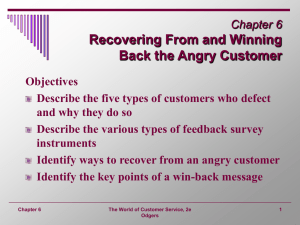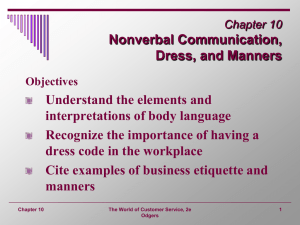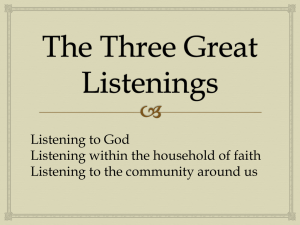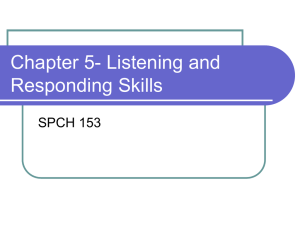ch5-9
advertisement
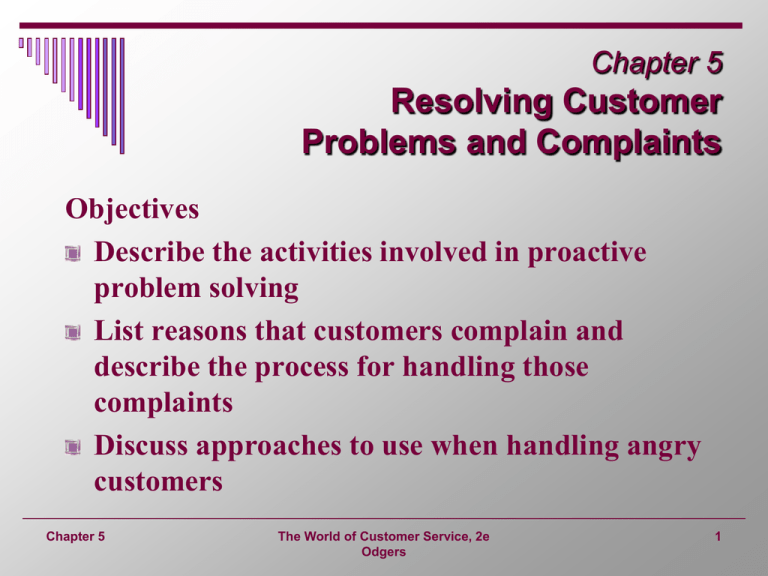
Chapter 5 Resolving Customer Problems and Complaints Objectives Describe the activities involved in proactive problem solving List reasons that customers complain and describe the process for handling those complaints Discuss approaches to use when handling angry customers Chapter 5 The World of Customer Service, 2e Odgers 1 Solving Customer Problems Use Proactive Problem Solving and Customer Self-Service (CSS) to exceed customers’ expectations by anticipating and solving problems before they occur. Example: At the time of sale, educate and inform buyers about extra costs and possible delays. CSS empowers customers to go to a company’s website and readily find information, view a bill, analyze service usage, compare rate plans, order new products and services. Chapter 5 The World of Customer Service, 2e Odgers 2 Solving Customer Problems When writing service-related email to customers, remember to Restate the customer’s question in the opening paragraph of the email Use headings to organize the email Make the email brief by linking to detailed information online Use consistent formatting to indicate procedures or instructions Write for easy reading and comprehension Chapter 5 The World of Customer Service, 2e Odgers 3 First-Call Resolution (FRC) FCRs are calls that CSRs resolve on that first call by the customer. FCRs positively affect a company’s bottom line because nearly 80% of the time and cost of providing customer service is spent on service resolution. Chapter 5 The World of Customer Service, 2e Odgers 4 The Quiet Customer Categories of the Quiet Customer 1. 2. 3. 4. 5. Chapter 5 The Satisfied Client The Accumulator The Thinker The Runner The Busy Bee The World of Customer Service, 2e Odgers 5 Resolving Customer Complaints The overriding reason customers complain is because their expectations for the product or service have not been met. Chapter 5 Why customers complain: Poor service or product quality Lower prices elsewhere CSRs lack of knowledge Company policies that create bureaucracy CSRs inability to solve problems Inflexible service Slow responses The World of Customer Service, 2e Odgers 6 Steps in the Complaint– Handling Process 1. Screen and log in information 2. Listen 3. Empathize 4. Solicit feedback 5. Apologize Chapter 5 6. Deliver bad news positively 7. Take ownership and formulate a solution 8. Communicate a solution 9. Follow up The World of Customer Service, 2e Odgers 7 Problem-Solving Process (Five Steps) 1. 2. 3. 4. 5. Identify the problem Analyze the problem Identify decision criteria Develop multiple solutions Choose the optimal solution Chapter 5 The World of Customer Service, 2e Odgers 8 Dealing with Unruly Customers Why customers get angry: The customer didn’t get what was promised or what was expected. Someone was rude to the customer. Someone was indifferent to the customer. No one listened to the customer. Chapter 5 The World of Customer Service, 2e Odgers 9 Customer Emotions and Service Recovery When customers are dissatisfied, they become difficult, frustrated, and quick to anger. A genuine apology is an excellent first step to diffuse customer anger. Know the difference between trigger phrases and calming phrases when dealing with customer emotions. Service recovery examples: cash refunds, credits, discounts, and apologies. Chapter 5 The World of Customer Service, 2e Odgers 10 Chapter 6 Recovering From and Winning Back the Angry Customer Objectives Describe the five types of customers who defect and why they do so Describe the various types of feedback survey instruments Identify ways to recover from an angry customer Identify the key points of a win-back message Chapter 6 The World of Customer Service, 2e Odgers 11 Understanding Why Customers Leave 1. 2. 3. 4. 5. Unintentionally pushed-away Intentionally pushed-away Pulled-away Bought-away Moved-away Chapter 6 The World of Customer Service, 2e Odgers 12 Understanding Why Customers Leave Indications that a customer is defecting The squeaky wheel The product return The quiet customer A slow pay Falling revenue and reduced sales volume Chapter 6 The World of Customer Service, 2e Odgers 13 Getting Feedback from Customers Feedback Tools Web-based surveys Mailed surveys Telephone surveys Comment cards Focus groups Feedback forms Chapter 6 The World of Customer Service, 2e Odgers 14 Issues to Measure on Feedback Surveys Ability to meet deadlines and on-time delivery Accurate invoice amounts Clear and helpful invoices Clear and helpful quotes, estimates, and proposals Follow-through on commitments Overall value and range of products and services Chapter 6 Presence of competent people and helpful CSRs Price Problem-resolution approach Prompt problem solving Prompt shipments Quality of product or service Shipments that match orders and specifications The World of Customer Service, 2e Odgers 15 Feedback Sources Employees Comment cards Competition Documentation and records Mail surveys Telephone surveys Chapter 6 The World of Customer Service, 2e Odgers 16 The Mystery Shopper A third-party person who anonymously and objectively evaluates a business relative to customer service, product quality, store presentation, and other areas These evaluators follow specific instructions during visits, complete written reports, and help to identify strengths and weaknesses of the business being visited Chapter 6 The World of Customer Service, 2e Odgers 17 Interpreting Customer Feedback Use thorough data-gathering and analysis techniques before acting on complaints. Do not spend lots of time, energy, and money gathering complaint data and then do nothing with it. Do not take feedback results personally. Inform customers about the impact their feedback has had on the way issues will be addressed. Chapter 6 The World of Customer Service, 2e Odgers 18 Recovering from the Angry Customer Listen and empathize Apologize Fix the problem quickly and fairly Keep your promises Make realistic and achievable promises Thank the customer Offer some form of compensation Follow up Chapter 6 The World of Customer Service, 2e Odgers 19 An Effective Win-Back Plan Win-back messages should Acknowledge the customer’s past patronage Point out improvements and changes made since the customer’s decision to stop buying Emphasize the ease with which the customer can re-engage and place another order Provide a financial incentive, if possible Chapter 6 The World of Customer Service, 2e Odgers 20 Chapter 7 Problem-Solving, Time and Stress Management Skills Objectives Describe the steps involved in solving customer problems Identify techniques to better manage time Discuss the importance of stress management Argue the difference between positive and negative stress Chapter 7 The World of Customer Service, 2e Odgers 21 Practicing ProblemSolving Skills Problem solving with customers is a process that involves four steps: 1. Determine whether the situation is a disagreement or a true conflict of interest. 2. Analyze your interests and the customer’s interests. 3. Brainstorm solutions and generate ideas together. 4. If step 3 doesn’t resolve the situation, make some mutual low-priority concessions. Chapter 7 The World of Customer Service, 2e Odgers 22 Practicing Problem-Solving Skills The price of service goes up when complaints are passed on to the next level in the organization. Accessibility, ownership, explanation of policies, and follow-through promote effective problem solving in the most efficient manner. Chapter 7 The World of Customer Service, 2e Odgers 23 Improving Time-Management Skills While organizing your time, ask yourself: What do I want or need to do that I am currently not doing? What do I want or need to complete that has not yet been completed? What do I want or need to start that has not yet been started? What do I want or need to say that I am not saying? Chapter 7 The World of Customer Service, 2e Odgers 24 Time-Management Tips Know your purpose Keep your time in perspective Plan ahead Set your priorities Break a project into smaller pieces Pace yourself Chapter 7 The World of Customer Service, 2e Odgers 25 Procrastination and Time Management Procrastination is the act of putting something off and comes in several forms: Not wanting to do the task Interrupting yourself Making the project too big Convincing yourself of defeat Rationalizing it away Feeding poor self-esteem Chapter 7 The World of Customer Service, 2e Odgers 26 Organizational Skills Some activities to use as a matter of routine Prepare a monthly schedule Prepare a file folder for each item on your schedule Rely on technology Organize your work area Manage your communications Chapter 7 The World of Customer Service, 2e Odgers 27 Understanding Stress When unregulated, uncontrolled, or ignored, stress can be harmful to your health and wellbeing. Conversely, too little stress can lead to apathy, fatigue, and illness. The key is to find and maintain a personal balance that works for you at each state of your life. Chapter 7 The World of Customer Service, 2e Odgers 28 Stress: Causes and Ways to Reduce Causes of Stress Lack of control Lack of confidence or self-esteem Chapter 7 To reduce stress Don’t worry Set goals Finish unfinished business Resolve conflicts The World of Customer Service, 2e Odgers 29 Managing Stress Pay attention to yourself Don’t try to control everything Alter your lifestyle Change your thinking Create an outlet Chapter 7 The World of Customer Service, 2e Odgers 30 Chapter 8 Communication Essentials Objectives Explain each of the elements in the communication process Identify the behaviors of people who communicate using different communication styles Compose examples of open, probing, closed, alternative choice, leading, and direct questions Understand the fundamentals of business writing Chapter 8 The World of Customer Service, 2e Odgers 31 The Basics of Communication Communication has been successful if there is shared understanding between two or more persons. Seven elements in the communication model 1. 2. 3. 4. 5. 6. 7. Chapter 8 The sender The receiver A message Signals The brain Shared understanding Feedback The World of Customer Service, 2e Odgers 32 Service-Oriented Communication Listening skills that make the other person feel heard Questions framed in a respectful manner A willingness to perform the work needed to reach a desired goal An ability to remain calm and centered, despite chaos or challenge Chapter 8 Flawless follow up A demonstrated understanding of the other person’s perspective An ability to anticipate the client’s needs A calm and pleasant tone of voice Honest communication Ease with admitting fault The World of Customer Service, 2e Odgers 33 Communication Styles Aggressive–closed-minded, listens poorly Fosters resistance, defiance and retaliation Passive–indirect and hesitant to say what is on the person’s mind Tends to agree externally, while disagreeing internally Assertive–an effective active listener Is open to negotiating, bargaining, and compromising in ways that everyone wins Chapter 8 The World of Customer Service, 2e Odgers 34 Communicating with Customers in Person When asking questions, use an assortment of Open questions Probing questions Closed questions Alternative choice questions Leading questions Direct questions Chapter 8 The World of Customer Service, 2e Odgers 35 Communicating with Customers in Person When answering questions, first Understand the question Decide whether you know the answer Remember, you are the expert Take enough time Smile Never answer a question with a question Be careful with your power When you don’t know, admit it Chapter 8 The World of Customer Service, 2e Odgers 36 Positive Language versus Negative Language Positive Language Projects a helpful, encouraging feeling rather than a destructive, negative one When used, it softens the impact of unpleasant news Chapter 8 Negative Language Conveys a poor image to customers and may cause conflict and confrontation where not necessary or desired Examples of negative words: cannot, won’t, will not The World of Customer Service, 2e Odgers 37 Fundamentals of Business Writing CSRs need to compose documents (emails to formal letters) that educate, persuade, inform, or enlighten the customer. Most important strategy when writing is to be clear. The costs of sloppy and poorly written documents with spelling and grammatical errors can be staggering to organizations. Chapter 8 The World of Customer Service, 2e Odgers 38 Steps to Use when Writing Business Documents Identify the audience, then put yourself in your audience’s shoes as you write for understanding. Write clearly with a purpose in mind. Present your message in concise, easy-to-understand, and grammatically correct language. Get to the point by presenting your primary message or call to action as quickly as possible. Chapter 8 The World of Customer Service, 2e Odgers 39 Use the Proper Tone Tone refers to the writer’s attitude toward the reader and the subject of the message. Be confident Be courteous and sincere Use nondiscriminatory language Stress the benefits for the reader Chapter 8 The World of Customer Service, 2e Odgers 40 Chapter 9 Customer-Focused Listening Skills Objectives Distinguish among the three levels of listening. Explain the importance of active listening. Develop techniques for becoming an effective listener. Describe barriers of effectively communicating and listening. Identify techniques for communicating with ESL speakers. Chapter 9 The World of Customer Service, 2e Odgers 41 Three Levels of Listening Level 1 Listening Characterizes a good listener who suspends judgment, is empathetic, and who listens with a high degree of understanding and respect Level 2 Listening Describes a listener who mainly listens to words, but does not fully understand what the words mean Level 3 Listening Describes a listener who may be daydreaming, forming a premature reply or faking attention Chapter 9 The World of Customer Service, 2e Odgers 42 Active Listening Means listening with your whole mind and body—not just your ears Five strategies that help improve active listening skills 1. 2. 3. 4. 5. Chapter 9 Be ready to listen Be ready to take notes Demonstrate that you are listening Ask questions Restate the customer’s points The World of Customer Service, 2e Odgers 43 Strategies for Effective Listening Realize that listening is hard work Make good use of the thought-speech ratio Seek to listen in more than one way Give the speaker space Don’t begin speaking the moment the person stops talking Develop an open posture that encourages the other person to talk Chapter 9 The World of Customer Service, 2e Odgers 44 Listening Techniques 1. 2. 3. 4. 5. Pay attention Ask follow-up questions Be courteous 7. Listen with your Nod your head entire body Repeat the statement 8. Respect the other Don’t be judgmental person Chapter 9 6. The World of Customer Service, 2e Odgers 45 Three Types of Feedback Reflective feedback mirrors content and intent “If I understand you correctly, what you are saying is…” Responsive feedback characterizes the listener’s feelings “When you [action], I feel [reaction].” Reactive feedback reaffirms the speaker’s message “I had a similar experience. It was…” Chapter 9 The World of Customer Service, 2e Odgers 46 Passive Listening and Selective Listening Passive listening is characterized by hearing without sending any feedback It offers no indication of acceptance or rejection of the message. Chapter 9 Selective Listening is hearing only what you want to hear, filtering out what is not important or of no interest to you. The World of Customer Service, 2e Odgers 47 Empathetic Listening Empathy is seeking to understand the other person’s position without getting emotionally involved yourself. Putting yourself in the customer’s place can help you analyze the message from his her perspective. Chapter 9 Guiding principles Be attentive Be interested in the speaker’s needs Listen with a caring attitude Act as a mirror Don’t get personally involved Use verbal cues The World of Customer Service, 2e Odgers 48 Roadblocks to Communicating and Listening 1. 2. 3. 4. 5. 6. Judging or criticizing Naming or labeling Commanding or ordering Moralizing Diverting Advising Chapter 9 The World of Customer Service, 2e Odgers 49 Effective Communication with Non-Native Speakers ESL (English as a second language) customers have studied English and generally comprehend it, but may have difficulty speaking it for several reasons. Chapter 9 To help these speakers Avoid making judgments about incorrectly accented speech Be a patient listener Don’t finish the speaker’s sentences Don’t correct grammar and pronunciation errors Don’t pretend to understand The World of Customer Service, 2e Odgers 50
